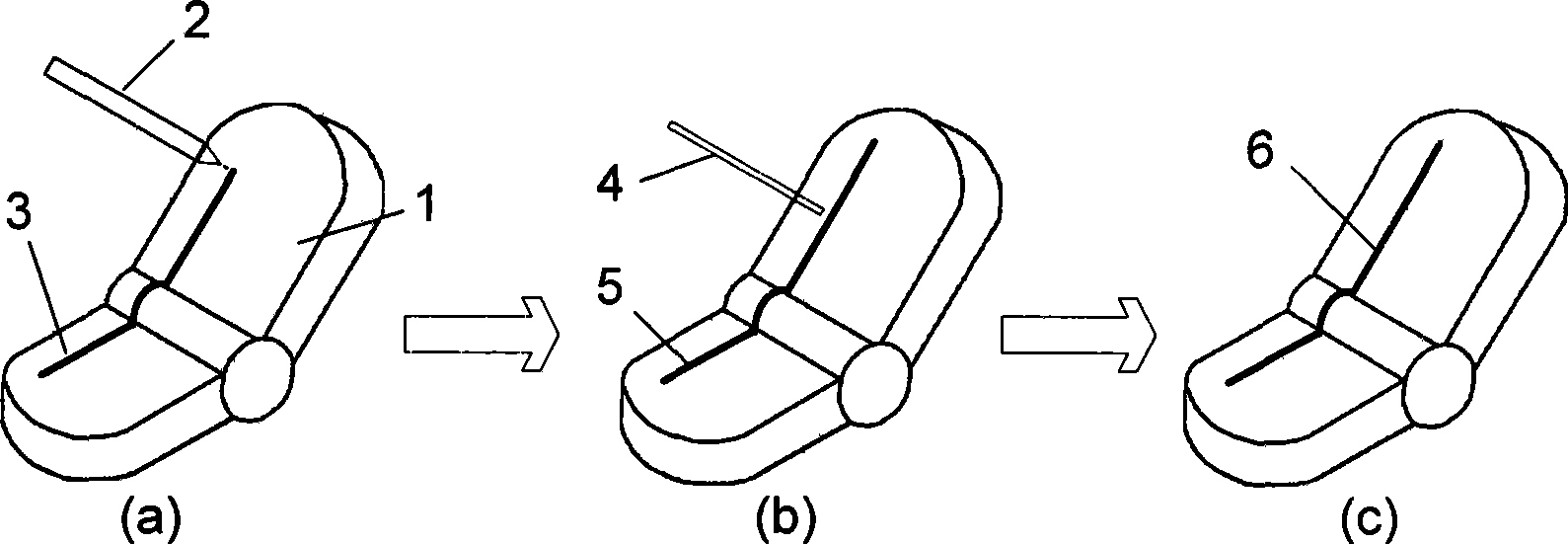Manufacturing and repairing method for conductive circuit of three dimensional mold interconnecting device
A technology for molding interconnection and conductive lines, which is used in printed circuit manufacturing, printed circuit, conductive pattern formation, etc. Material cost reduction, low cost effect
- Summary
- Abstract
- Description
- Claims
- Application Information
AI Technical Summary
Problems solved by technology
Method used
Image
Examples
Embodiment 1
[0042] The molded structural parts used in this embodiment are made of polystyrene (PS) and formed by compression molding, and the conductive paste used is gold-based paste. First, using the micro-pen direct writing deposition process, according to the spatial trajectory of the conductive path designed and generated by CAD software, the conductive paste is preset on the molded structural parts to form a preset paste layer of about 10 microns, and dried at 90°C for 30 minutes to remove organic solvents. Then, use a continuous Nd:YAG laser with a maximum output power of 50W to scan and irradiate the dried preset slurry layer according to the conductive path space trajectory designed and generated by CAD software, with a scanning speed of 10mm / s and a single scanning line The width is 100 microns, and the wider pre-set slurry layer is scanned by multiple laps. Thereafter, electroless copper plating and nickel plating are performed sequentially according to the standard process, ...
Embodiment 2
[0044] The molded structural part used in this embodiment is made of liquid crystal polymer (LCP) material, which is formed by injection molding process, and the conductive paste used is gold-based paste. First, using the micro-nozzle direct writing deposition process, the conductive paste is preset on the molded structural parts into a preset paste layer of about 5 microns according to the spatial trajectory of the conductive path designed and generated by the CAD software, and dried at 85°C for 30 minutes to remove the organic solvent. Then, using a continuous CO with a maximum output power of 100W 2 The laser also scans the dried preset slurry layer according to the conductive path space trajectory designed and generated by the CAD software. The scanning speed is 25mm / s, and the single scan line width is 120 microns. The wider preset slurry layer is The scanning is completed by multi-pass overlapping. After that, electroless copper plating and nickel plating are carried ou...
Embodiment 3
[0046] The molded structural parts used in this embodiment are made of polyethylene (PE) and formed by compression molding process, and the conductive paste used is copper-based paste. First, using the micro-nozzle direct writing deposition process, the conductive paste is preset on the molded structural parts into a preset paste layer of about 10 microns according to the spatial trajectory of the conductive path designed and generated by the CAD software, and dried at 80°C for 40 minutes to remove the organic solvent. Then, use a continuous Nd:YAG laser with a maximum output power of 50W to scan the dried preset slurry layer according to the conductive path space trajectory designed and generated by the CAD software. The scanning speed is 15mm / s, and the single-scanning linewidth 100 microns, and the wider preset slurry layer is scanned by multiple laps. After that, electroless copper plating and chrome plating are performed sequentially according to the standard process, and...
PUM
| Property | Measurement | Unit |
|---|---|---|
| Thickness | aaaaa | aaaaa |
| Thickness | aaaaa | aaaaa |
| Thickness | aaaaa | aaaaa |
Abstract
Description
Claims
Application Information
 Login to View More
Login to View More - R&D
- Intellectual Property
- Life Sciences
- Materials
- Tech Scout
- Unparalleled Data Quality
- Higher Quality Content
- 60% Fewer Hallucinations
Browse by: Latest US Patents, China's latest patents, Technical Efficacy Thesaurus, Application Domain, Technology Topic, Popular Technical Reports.
© 2025 PatSnap. All rights reserved.Legal|Privacy policy|Modern Slavery Act Transparency Statement|Sitemap|About US| Contact US: help@patsnap.com


